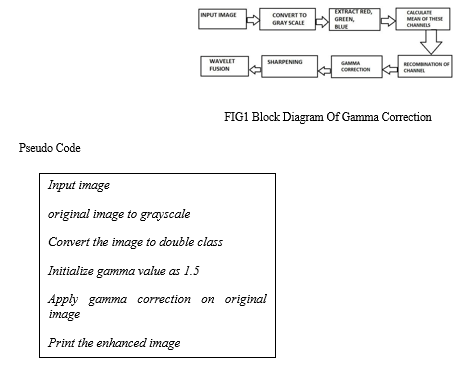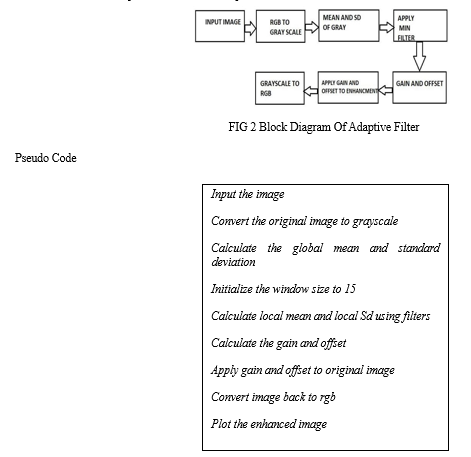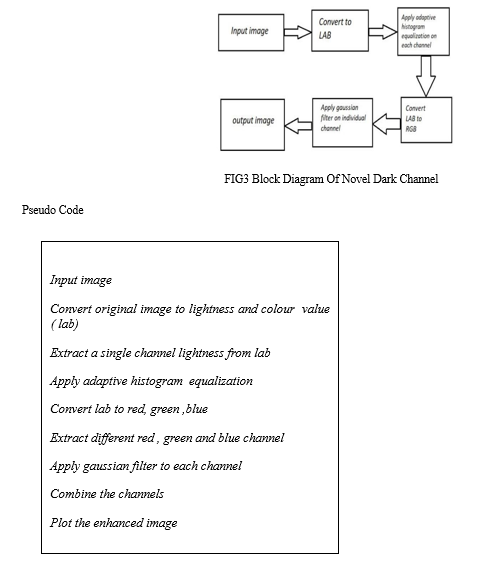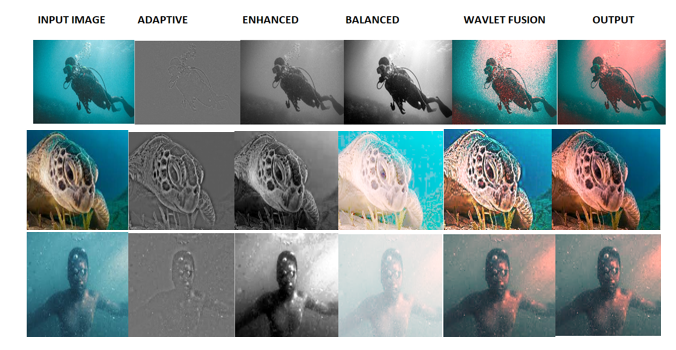Ijraset Journal For Research in Applied Science and Engineering Technology
- Home / Ijraset
- On This Page
- Abstract
- Introduction
- Conclusion
- References
- Copyright
Sub Aquatic Image Correction with Oceanic Species Eye Mechanism using MATLAB
Authors: Kratika Kaushik, Kriti Sharma, Siddharth Jain
DOI Link: https://doi.org/10.22214/ijraset.2023.53077
Certificate: View Certificate
Abstract
Our work is based on the idea of improving underwater images based on the structure and function of the subaquatic ocean species retina. Our goal is to solve image degradation problems caused by blurry and uneven colors. Our design also compares various image enhancement techniques using different filters and contrasts and compares the results. Fishes have retinas with rods and cones that help them to see images clearly under the water. Color contrast is specially corrected using the red correction line and feedback from the horizontal line. Because a single image is used, this method does not require special equipment or knowledge of underwater structures or the underwater environment. Higher contrast, sharper edges and better visibility in the dark means better photos and videos. The algorithm is mostly independent of camera settings.
Introduction
I. INTRODUCTION
has many unique features such as underwater environment, marine life, fish, breath-taking scenery and shipwrecks. It has also become an important part of many arts and sciences, including underwater art, marine biology, archae ology, artifact analysis, underwater vehicle management, and the study of the underwater system. Unlike ordinary images, underwater images appear less visible mainly due to reduced light exposure due to absorption and scattering. In ocean images, anything more than 10 meters away is nearly invisible, and color gradually fades with wavelengths causing the color to be cut off with the depth of the water. Underwater image distortion caused by matching and splicing appears to be limited to traditional enhancement methods such as gamma correction and histogram equalization.
Light weakens as it moves through water, which can cause noise, discoloration, and low contrast in underwater i mages. These problems add to the complexity of many tasks, including automatic identification and identification of fish and plankton. Our model enhances and removes the noise in an image captured by the camera. The white balance level eliminates negative colors caused by underwater lighting, making underwater images look better. The reddish hue in high density image is more compensated. A fusion based method is to use fusion based on gamma correction and sharpening to resolve the ambiguity in the original image.
Our model also compares various image enhancements. I n this article, we show you how to improve images using three algorithms namely gamma correction, adaptive filter and novel dark channel.
II. LITERATURE SURVEY
- Existing underwater image enhancement techniques can be divided into several categories.
- That implements the above model [1],[4],[5],[9] using a software system. Software-based approaches focus on multiple parameters and use multiple methods to solve problems.
- Various noise reduction strategies have been proposed [2], [3], [4]. The best result for the filter cannot be predicted for each image by developing a quality system based on global comparison [2]. Noise can be reduced using two-dimensional filters and automatic color correction, helping to improve contrast and remove blurring of images [3].
- Various techniques use software-based methods to enhance images [1], [5], [6], [7].
- Some evidence suggests that most, if not all, pretreatment can be done using general techniques that do not require knowledge of the nature or properties of water, while following the underwater model. [4]]. Some are created by combining two images from white-balanced images and color-corrected raw images. [5]. Using the retina along the same path can be done using 3 methods, the first and the last two paths of the path [4], and the combination of
- The two with the retina increasing the contrast and improving the image quality [6], [7].
- Water has different spectral densities in different places. The model also takes into account wavelength changes due to various spectral densities and turbidity of water velocity. [9] We found that the Sub aquatic image correction p issue can be reduced by removing the blurriness in a single image by estimating two additional world parameters, the blue-red and the blue-green ratio, where all color channels have the same attenuation coefficient. 10]
III. APPLICATIONS
Underwater Image Enhancement Using MATLAB's Adaptive Retina Mechanism has wide applications in various fields such as Marine Biology, Oceanography, Underwater Surveillance and Underwater Robots.
Here are some specific applications:
- Marine Biology: Improving underwater images using retinal correction techniques can help marine biologists better study marine life. It can help identify different species of fish, coral reefs and other marine life.
- Oceanography: Underwater image enhancement can be used to improve the image quality of underwater cameras and can be used for seabed survey, seafloor mapping and underwater geological characterization.
- Underwater Surveillance: Underwater image enhancement helps improve the image quality of underwater cameras used for underwater surveillance. This can be used to identify underwater threats such as land mines or enemy submarines.
MATLAB provides a simple platform for implementing and testing image enhancement algorithms, including those based on retinal reconstruction techniques. Using MATLAB, scientists and engineers can develop and optimize algorithms to improve underwater images and make their use underwater more efficient and accurate.
IV. METHODOLOGY

obtained. This image has been captured in RGB format. a red, green, and blue section of an image. The pre-processing stage involves of setting the acquired image in focus; the higher the pixel values, the more is focus value. In order to provide a highly targeted output, this algorithm selects the in-focus areas from each and every input snapshot by choosing the best value for each and every pixel. Each image's P I j) pixel value is measured and contrasted with one another.
Pre-processing
Pre-processing is a stage of image processing that includes a variety of steps that vary depending on the input image. Pre-processing is done on the input image after it is taken from a source. The RGB image is transformed into a grayscale image with a pixel range of 0 to 255. The pre-processing stage includes the filtering procedure.
This filtering procedure lowers the amount of noise in the image.
Detection
The detecting procedure that involves improving the image that is used as an input image. Using the HWD transform technique, the planned work augmentation procedure is carried out. By this method, noise can be reduced and image quality is enhanced.
V. THE FISH RETINA INSPIRED MODEL
A. Photoreceptors
photoreceptors form the first layer of the retina and can be divided into rods and cones and send signals for neural responses. Based on their sensitivity to spectral wavelengths, cones can be divided into three types: R,G,B types [60]. From the underwater image, we split
the Red, Green and Blue lines fred(a,b), fblue(a,b), fgreen(a,b) and use them as input for the cone. The luminance signal received by the bars is easily identifiable: L (a,b) = (fred(a,b) + fgreen (a,b) + fblue (a,b)) / 3
B. Horizontal Cells
The horizontal cells (HC) of the retina have the largest RF size, allowing them to shuffle photoreceptor information over a wide area. Initial feedback is from HCs to photoreceptors.
C. Bipolar Cells
A number of bipolar cells in the retina divide signal processing into on and off. fbc (x, y) = COλ (x, y)  Bpγ rod
Bpγ rod
D. Ganglion Cells
Fish eyes have more red and green ganglion cells than blue ganglion cells. The blue underwater area adjustable from is complementary to red and green at the ganglion level.
To enhance the color, we chose a cell attack with the mechanism of red-green-blue-yellow color antagonism and perfected the image for human visual system display.
VI. ALGORITHMS
A. Gamma Correction
The clarity of digital images may be affected by limitations of imaging equipment or poor environmental conditions. Despite significant advances in imaging science, captured images do not always meet user expectations for clarity and simplicity. Most of the techniques currently used focus on general or local development, which may not apply to all types of images. These techniques do not deal with the nature of the image and many classes of distorted images will require different treatments. Therefore, using the statistics of an image, we divide the image into several groups.Adaptive gamma correction (AGC) is adjusted dynamically according to the image data. Based on quality and diversity tests and extensive testing, AGC outperforms other cutting-edge methods.

Input the original image . Convert the image to grayscale and change its class to double. Give the gamma value as 1.5 and apply gamma correction algorithm to original image. Plot the enhanced image
B. Adaptive Filter
To locate the pixels impacted by impulse noise, the adaptive filter uses spatial processing. Adaptive filters are typically used to restore image pixels by eliminating noise without subtly blurring the image's extant structures. The adaptive filter labels those pixels as noise by drawing comparisons between each pixel in the picture and its adjacent pixels. The neighbourhood size is adaptable. Impulse noise is defined as pixels that are very different from the majority of their neighbours because it is not adjusted to the pixels in the comparable picture. The test meets the criteria for noise labelling when the neighbourhood noise pixels are used to substitute the middle pixel estimation of the pixels Pseudo

Input the original image. Convert it to grayscale for the calculation of mean and standard deviation. Calculate the global and local mean with window size specified as 15. Apply gain and offset to original image and convert it back to rgb . Plot the enhanced image
C. Novel Dark Channel
Dark Channel is image processing with MATLAB refers to the technique to estimate haze and fog in the underwater image . Based on the observation that most outdoor sceneries, even those with haze, contain regions with very low intensity values because of the presence of sky pixels or shadows, the theory was developed. A statistical characteristic of outdoor photographs is known as the "dark channel prior," which asserts that in haze-free areas, at least one colour channel of a local image patch has very low pixel values. With the aid of this prior, we can calculate the transmission map.
In both consumer/computational photography and computer vision applications, haze reduction (or dehazing) is widely desired. First, removing the haze can greatly improve the scene's visibility and rectify the colour shift brought on by the air light. The image with less haze is typically more visually appealing. Second, the majority of computer vision algorithms—from basic image analysis to sophisticated object recognition—generally take the input image—after radiometric calibration—to represent the radiance of the scene. Finally, haze removal can generate depth information that is useful for advanced image editing and many vision algorithms. A useful depth clue for scene comprehension is haze or fog. The unfavourable haze image

Take the original raw underwater image as the input. Using MATLAB, we perform color space conversion, specifically converting the image from the red, green, and blue (RGB) channel to the LAB color space. In the LAB color space, the luminance component (L) represents the brightness of the image, while the 'a' and 'b' components represent the color information.
Next, we extract the single luminance channel (L) from the LAB image. Apply adaptive histogram equalization to the original image. Adaptive histogram equalization is a technique used to enhance the contrast and improve the overall appearance of an image. After the histogram equalization step, we convert the LAB image back to the RGB color space. This conversion allows us to work with the individual red, green, and blue channels once again. Using MATLAB, we separate these channels.
With the separated red, green, and blue channels, we apply a Gaussian filter to each channel.
Finally, we combine the filtered red, green, and blue channels back into a single image. This merged image represents the enhanced version of the original underwater image, with improved brightness, contrast, and overall visual appeal. Using MATLAB's plotting capabilities, we generate a plot showcasing the enhanced version of the image, allowing us to visually assess the improvements made throughout the image enhancement pipeline.

Conclusion
In this study, we created a new Sub aquatic image correction model using oceanic species eye mechanism that simultaneously takes into account the retinal adaptations of teleosts and the characteristics of the underwater environment. Our model enhances and eliminates noise in an image captured by a camera. We created three algorithms namely Gamma Correction, Adaptive filter and novel dark channel load images. We also compared with the results of the previous method using the filter designed. We observed that by using gamma correction algorithm image quality improved but still scope for enhancement were observed secondly in, adaptive filter algorithm edge detection was done accurately though no significant enhancement was observed in image quality but after the creation of last algorithm that is novel dark channel load images significant quality and enhancement in image was observed. Hence, we conclude that novel dark channel load images produced the best results.
References
[1] R. Schettini and S. Corchs , \"Underwater image processing: State of the art of restoration and image enhancement methods\", EURASIP J. Adv. Signal Process., vol. 2010, Dec. 2010. [2] E. Trucco and A. T. Olmos-Antillon, \"Self-tuning underwater image restoration\", IEEE J. Ocean. Eng., vol. 31, no. 2, pp. 511-519, Apr. 2006. [3] H. Lu, Y. Li and S. Serikawa, \"Underwater image enhancement using guided trigonometric bilateral filter and fast automatic color correction\", Proc. IEEE Int. Conf. Image Process., pp. 3412-3416, Sep. 2013. [4] A. Arnold-Bos, J. P. Malkasse and G. Kervern, \"Towards a model-free denoising of underwater optical images\", Proc. IEEE Eur. Oceans Conf., vol. 1, pp. 527532, Jun. 2005. [5] C. O. Ancuti, C. Ancuti, C. De Vleeschouwer and P. Bekaert, \"Color balance and fusion for underwater image enhancement\", IEEE Trans. Image Process., vol. 27, no. 1, pp. 379-393, Jan. 2018 [6] X. Fu, P. Zhuang, Y. Huang, Y. Liao, X.-P. Zhang, and X. Ding, “A retinex-based enhancing approach for single underwater image,” in 2014 IEEE International Conference on Image Processing (ICIP). IEEE, 2014, pp. 4572–4576. [7] C. Ancuti, C. O. Ancuti, T. Haber, and P. Bekaert,“Enhancing underwater images and videos by fusion,” in Computer Vision and Pattern Recognition (CVPR), 2012 IEEE Conference on.IEEE, 2012 [8] S. Bazeille, I. Quidu, L. Jaulin, and J.-P. Malkasse,“Automatic underwater image preprocessing,” in CMM’06, 2006 [9] D. Berman, T. Treibitz, and S. Avidan, “Diving into hazelines: Color restoration of underwater images,” in Proc. British Machine Vision Conference (BMVC), vol. 1, no. 2, 2017 [10] H. Lu, Y. Li, L. Zhang, and S. Serikawa, “Contrast enhancement for images in turbid water,” JOSA A, vol. 32, no. 5, pp. 886–893, 2015
Copyright
Copyright © 2023 Kratika Kaushik, Kriti Sharma, Siddharth Jain. This is an open access article distributed under the Creative Commons Attribution License, which permits unrestricted use, distribution, and reproduction in any medium, provided the original work is properly cited.

Download Paper
Paper Id : IJRASET53077
Publish Date : 2023-05-26
ISSN : 2321-9653
Publisher Name : IJRASET
DOI Link : Click Here
 Submit Paper Online
Submit Paper Online

